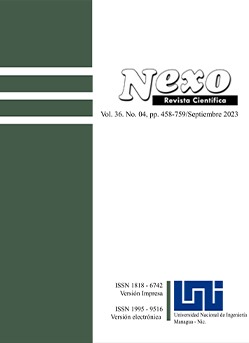Retrospective analysis of the socioeconomic impact generated by coffee rust (Hemileia vastatrix ) in the department of Paraíso Honduras
DOI:
https://doi.org/10.5377/nexo.v36i04.16755Keywords:
coffee, production, Hemileia vastatrix, rust, socioeconomicsAbstract
Honduras is a country where its economy is highly dependent on some important items such as coffee (Coffea arabica L.). According to the Central Bank of Honduras, this product contributes 4.8% to the national GDP and 34.8% of agricultural GDP, ranking third as a foreign exchange generator in the country only after maquila and remittances. Around 112 thousand families depend on this crop, 85% is in the hands of small producers (less than 100 quintals), the remaining 15 is in the hands of medium and large producers. In the last decade coffee has been affected by the rust disease Hemileia vastatrix, which causes serious damage to coffee plantations, mainly due to the poor agronomic management of the crop and the effect of climate change, generating a very unstable socioeconomic impact throughout the country and especially in coffee areas such as the Paradise region. that despite the measures that have been adopted, 60% of the coffee farms that exist in the department have been affected between the two seasons 2011-2012/2012-2013 causing a socioeconomic problem to producers and the entire coffee value chain, and the reduction of foreign exchange for the country of US $ 645.1 million for coffee sales in the 2011-2012 harvest; Similarly, the harvest has been significantly affected in the 2017-2018 harvest, causing a significant decline in exports of the gold grain, where production fell by 1.3 million bags. Therefore, the government and all actors in the sector must develop efficient technical and scientific strategies to counteract rust, and be able to build knowledge to be transferred to coffee producers who are ultimately the most affected.
Downloads
1623
Downloads
Published
How to Cite
Issue
Section
License
Copyright (c) 2023 Universidad Nacional de Ingeniería

This work is licensed under a Creative Commons Attribution 4.0 International License.
The authors who publish in Nexo Scientific Journal agree to the following terms:
- Authors retain the copyright and grant the journal the right of the first publication under the license Creative Commons Attribution License, which allows others to share the work with a recognition of the authorship of the work and the initial publication in Nexo Scientific Journal.
- Authors may separately establish additional agreements for the non-exclusive distribution of the version of the work published in the journal (for example, in an institutional repository or a book), with the recognition of the initial publication in Nexo Scientific Journal.
- Authors are allowed and encouraged to disseminate their works electronically (for example, in institutional repositories or in their own website) before and during the submission process, as it can lead to productive exchanges, as well as earlier and greater citation of published works.










